“Aluminum laser cutting is a valuable manufacturing method for several shapes and patterns required across industries. “

Aluminum sheets or workpieces need to be cut into different shapes and sizes while manufacturing aluminum parts & products. Laser cutting, plasma cutting, CNC cutting, are a few common types of cutting techniques for aluminum alloys. However, Aluminum Laser Cutting is particularly popular due to its clean & precise cutting nature. Laser beams can cut almost all aluminum alloy grades into complex shapes, patterns, or geometry.
Furthermore, this article will discuss laser cutting aluminum in detail, including the process, advantages, applications, and design guidelines at the end.
What is Aluminum Laser Cutting?
Laser cutting is an advanced and computer-controlled manufacturing technique that uses a highly intense beam of ionized gases(laser beam) to cut different materials, including aluminum. This Laser Cutting Sheet Metal technique is suitable for materials with thermal conductivity because the cutting mechanism involves melting & vaporizing the materials to create a cut using intense heat. Only the thermally conductive material will allow to flow the of heat to burn the material.
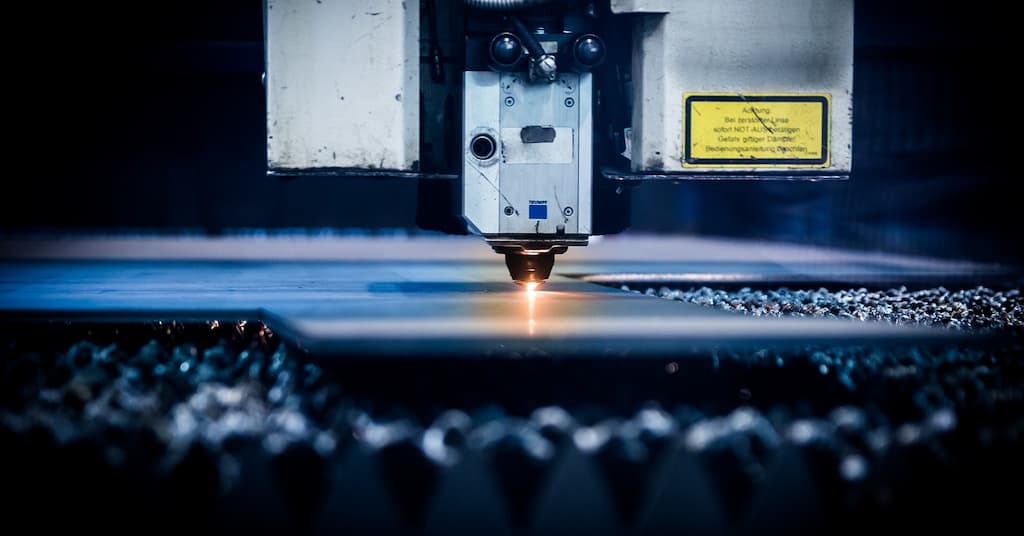
Laser cutting of aluminum sheet
Typically, aluminum laser cutting can cut sheets of thickness as high as 8 mm. It can be further increased depending on the power of the laser machine. Moreover, CNC Laser Cutting can accurately control the movement of the laser according to the uploaded CAD File. These benefits allow tight tolerances and a low laser cutting cost in the production of aluminum components.
The common aluminum alloys and grades used in laser cutting are 1100, 2024, 3003, 5052, 6061, 6063, 7050, and 7075.
Try Prolean Now!
The Aluminum Laser Cutting Process
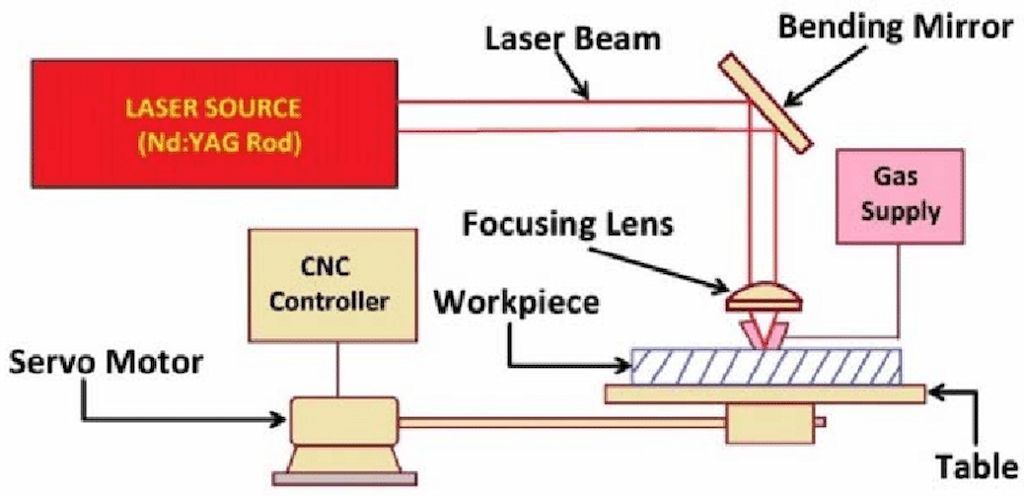
Laser cutting setup
Laser cutting of aluminum sheets involves different steps, from laser source management to laser head control. Here are the typical components of a laser cutting machine;
- Work Table: It supports the workpiece and provides stability during cutting. Different fixtures in the table hold the workpiece, but the table can move in X and Y directions.
- Laser Source: Primarily two types of laser CO2 and fiber lasers. Nd: YAG (fiber) laser is the most common.
- Beam Transmission: The laser beam produced by the Nd: YAG rod goes towards the workpiece. Meanwhile, the focusing lens concentrates the laser beam to a fine point on the workpiece surface.
- CNC Controller Unit: It directs the servo motor, adjusting the position of the laser head according to digital designs or patterns programmed in the computer.
- Gas Supply: In many laser cutting operations, an assist gas (such as oxygen, nitrogen, or air) is passed into the cutting zone through a nozzle to help clear away molten material and vaporized debris.
What Are the Challenges of Aluminum Laser Cutting?
Although aluminum laser cutting is a highly effective technique, it has some challenges regarding aluminum properties. The aluminum alloy surface is reflective and can reflect the portion of the laser beam if a slight adjustment or error happens in operational parameters and handling.
The other concerns regarding the standard processes and custom-cut aluminum sheet projects follow.
High Heat disappiation
The high thermal conductivity of aluminum can immediately dissipate the heat from the striking position into the surroundings, which might affect the uniformity between the upper and lower end of a cut.
Risk of Oxide and Anodized Layers
If the cutting surface is not thoroughly cleaned, especially oxides and the anodized layer, they interfere with the laser beam. This can result in laser cutting defects due to disturbance in the laser beam’s performance.
Material Warping
Material warping is another issue for complex custom cuts on aluminum sheets. Low melting points and high thermal conductivity can accumulate heat in small areas, warping and distortion.
Heat-affected Zone
The laser beam’s intense heat can damage the material’s properties surrounding the cutting position, such as fatigue strength, cracking, and distortion.
Burrs and Residue
The softness and thermal properties can increase burr formation and residue on the underside of cuts. As a result, laser-cut aluminum parts might require additional post-processing.
Aluminum Laser Cutting Design Guide
As previously mentioned, laser cutting or any standard or custom parts involves uploading a CAD file with all details and converting the drawing into machine-readable information. Then, the CNC automatically dictates the movement of the laser. So, the design is the foundation for any laser-cutting parts or products.
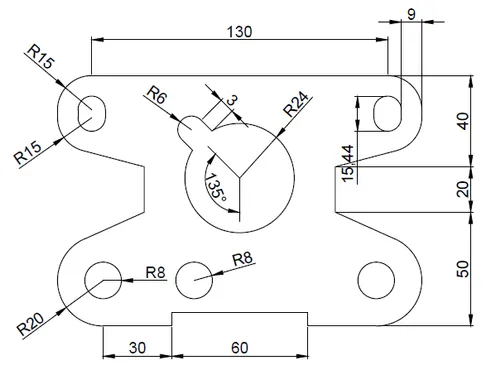
2D laser cutting design sample
The laser-cutting design of aluminum or any other component includes several features, like holes, edges, bends, engraves, and grooves. There are basic rules or guidelines to manage those features in a single blueprint.
1. Maintain the diameter of the hole according to the thickness of the sheet. (Hole diameter ≥ 50% of material thickness; not smaller than 0.015″).
| Material Thickness (inches) | Minimum Hole Diameter (inches) |
| 0.100 | 0.050 |
| 0.300 | 0.150 |
| 0.600 | 0.300 |
2. Avoid the intersection and overlap of cutting lines in design.
3. To counter the dimension errors caused by distortion, leave a distance at least two times the sheet thickness from the cutting position.
4. Consider the kerf in your custom-cut aluminum sheet design. It is the minor portion of burn-out material left after the aluminum sheets are laser cut.
5. The minimum distance between the hole and the bending edge should be two times the material thickness. Min bend dist.= 2t
Try Prolean Now!
Applications of Aluminum Laser Cutting
Laser cutting can produce industrial components, signage, boards, and custom-cut aluminum parts. Its applications span industries from automotive and electronics to architectural items.
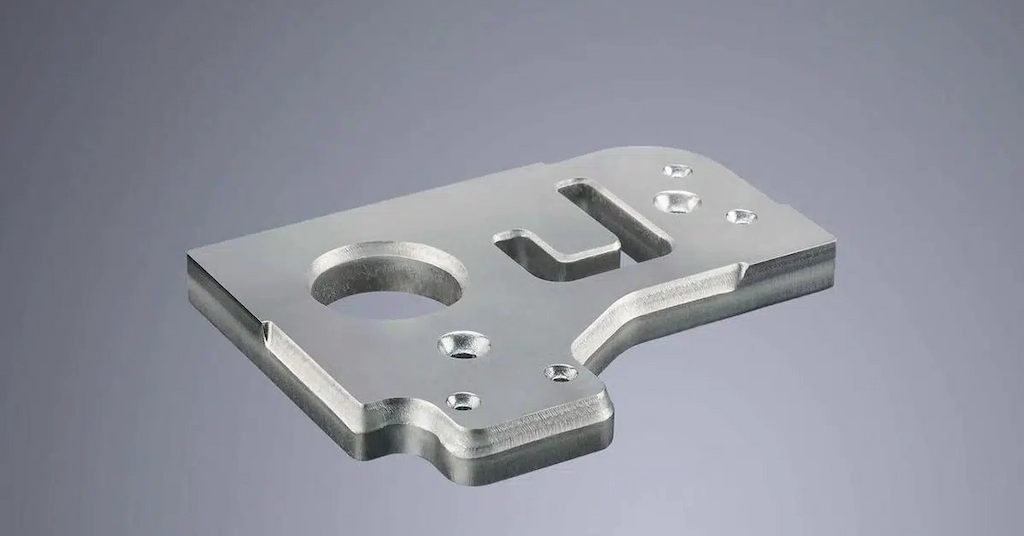
Aluminum laser cutting part
The main reasons for the popularity of Laser Cutting Applications in aluminum parts manufacturing are no-shear cutting, accuracy, and cutting speed. Furthermore, the following are the typical applications of custom-cut aluminum with laser beam technology.
Table: Aluminum Laser-cutting Applications
| Application Area | Reason for Using Laser Cutting | Specific Application Examples |
| Automotive | Precision in complex shapes and features | Aluminum body panels, decorative trim, chassis parts, door frames, suspension parts, etc. |
| Aerospace | High accuracy and durability | Structural frames, wing spares, Seat rails, and brackets. |
| Consumer Electronics | Fine detailing and design flexibility | Laptop frames, enclosures, heat sinks, electronic mounts, etc. |
| Architecture | Aesthetic appeal and customization | Window framing, Door details, custom fittings, balustrades, etc. |
| Industrial Machinery | Precision and Speed | Machine frames, conveyor components, mounting plates, gears, jigs & fixtures, etc. |
| Signage and Displays | Design versatility, customization, and fine detailing | Business signs and board, decorative logos, directional signage, exhibition panels, etc. |
Benefits of Aluminum Laser Cutting
The high thermal conductivity, low weight, and ductile nature of aluminum alloys make them perfect for laser cutting. The laser offers precision, speed, complex features, and many other many laser cutting advantages in aluminum cutting and shaping.
- High Precision and Accuracy: It provides exceptional accuracy and intricate design manufacturability.
- Smooth Edges and Quality Finish: The laser cutting process leaves behind clean and smooth edges, reducing the need for additional finishing processes.
- Rapid Prototyping and Production Speed: Laser cutting is highly efficient and fast, which makes it suitable for quick aluminum prototypes.
Aluminum Laser Cutting Services at ProleanTech
The expertise of engineers and operators equally influences the result of laser cutting along with the right equipment and tooling. At Proleantech, we have advanced 4-20 Kw of CNC laser cutting machines and experience in handling laser cutting aluminum projects for diverse industries since the last decade.
Furthermore, we can handle all aluminum grades and combine the custom-cut aluminum sheet with other fabrication methods like bending, stamping, etc. You can shape any parts or components with our CNC Laser Cutting Service. Send us your design to start the project with a quote from our factory engineers.
Read more: A Comprehensive Guide to Steel Laser Cutting: Precision and Efficiency at Its Best
Try Prolean Now!
Summing Up
Overall, laser cutting is an effective non-shear cutting method for aluminum sheets. Its ability of high speed and precision can make different shapes and patterns useful for countless applications across industries. Next, there are some challenges in aluminum laser cutting surface reactivity & material wrapping for quality results. However, proper design and use of the correct cutting variable provide the intended cuts in all aluminum grades.
FAQs
How does aluminum laser cutting work?
Aluminum laser cutting uses a high-power laser beam to precisely melt and vaporize aluminum material to achieve the desired cut.
What is the maximum aluminum thickness that a laser can cut?
The maximum thickness that a laser can cut aluminum typically depends on its power. For industrial-grade lasers, it is common to cut aluminum sheets up to about 25 mm thick.
Is aluminum laser cutting expensive?
The cost of aluminum laser cutting can vary depending on several factors, such as the thickness of the material, design complexity, and precision. However, it is generally cost-effective for medium to high-volume production due to its cutting speed.
What is the laser cutting speed for aluminum sheets?
The laser cutting speed significantly varies based on the laser power and thickness of the aluminum sheet. However, the most common speed is about 1,000–3,000 mm/min.



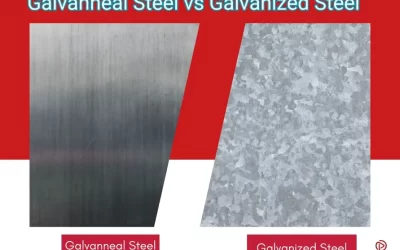
0 Comments